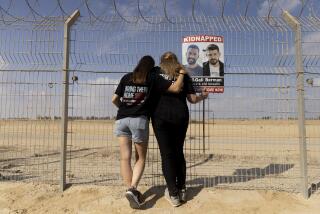Leaner, meaner military
Wrapping up our week, today our two Iraq veterans discuss how Donald Rumsfeld’s model of a lighter, faster Armed Forces has worked out in practice. Previously, they debated whether the surge is working, the pros and cons of involuntary service, the overstretched services and the need for a larger military.
Bigger and smarter, not leaner and meaner
By Phillip Carter
There is a tendency in war to view things from your own side. I remember planning my unit’s operations for war games at Fort Irwin, Calif., developing elaborate schemes which would impose our will on the notional enemy sitting across the desert. In Iraq, we developed elaborate plans too, and felt confident that we could achieve our objectives. According to this mindset, victory can be engineered through sufficient intelligence, innovation, and courage. The Rumsfeldian model of transformation embraces this optimistic view of warfare.
Unfortunately, the enemy gets a vote. And in today’s mode of warfare, the people get a vote too. Models of warfare which put too much faith in one side’s autonomy or abilities, while ignoring the synergistic interaction of the two (or more) sides, are doomed to fail because they ignore the human element of war. This was Defense Secretary Donald Rumsfeld’s undoing: he believed that a sufficient show of force and technology in 2003 could impose our will on the Iraqi people. And because he had chosen to fight with such a small, overcapitalized, technology-heavy force, he lacked the “boots on the ground” to fight the messier kind of war which emerged after our victory in April 2003.
Until the Iraq war, the U.S. embraced a “revolution in military affairs,” which stressed this Rumsfeldian view of war, with its premium on technology, training and doctrine. In conventional war, what Army officers like to call “kinetic” operations, everything ultimately comes down to sending a projectile downrange. Engineering new systems to aim and deliver that projectile - whether from an infantryman’s rifle or Joint Strike Fighter - improve the effectiveness of the modern system of warfare. Over the last 50 years, the “American way of war” developed along the lines of this precision firepower paradigm, substituting machines for men where possible, and providing increasingly sophisticated ways to detect, engage and destroy the enemy.
The American way of war also embraced a theoretical construct put forth by Alfred Thayer Mahan, a naval officer, who argued in the late 19th and early 20th centuries that the key to success in war was the destruction of the enemy. The two world wars played out under this strategic framework, with generals chasing each other’s armies in the quest for one great battle which would destroy the other and end the war. In Vietnam, senior American officers attempted to win the war with this mindset, but it clearly did not work in a place where the enemy was so elusive and the people so resistant to casualties, such that no amount of destruction could bring about victory.
A generation later, both these theories have run aground in Iraq. Our armed forces field an impressive array of technologies. I know, because I tested digital battle command systems for the Army in the late 1990s, and used these same systems in Iraq. But as sophisticated as these systems are, they cannot answer the basic questions which matter most in Iraq: who are your friends, and who are your enemies?
Likewise, we have reached the limits of what force can accomplish in Iraq. Killing more insurgents or militia members will not secure victory. We will only prevail when we succeed in securing the Iraqi people and earning their support. Kinetic operations have a place, but only as one part of this people-oriented paradigm of warfare. America does not need a leaner, meaner, more advanced army in Iraq. Instead, we need a bigger, smarter force with “full spectrum” capabilities that understands that the human element of warfare is paramount.
It’s been a pleasure discussing these important subjects with you, Austin. I look forward to continuing our dialogue soon.
Sincerely,Phil
Phillip Carter, an attorney with McKenna Long & Aldridge LLP in Los Angeles, is a former Army officer and an Iraq veteran.
Kinetic works, but it isn’t everything
By Austin Bay
Phil, it’s Friday and we’ve covered a lot of territory in five days, though in places to the depth of a West Texas “dry lake” in flood - suddenly the playa is a mile-wide pond three inches deep. The water’s often gone within a week, so the comparison is apt in more than one way.
You provide an excellent treatment of today’s topic. Popular history will saddle Rumsfeld with the sins of the military’s smart-guy crowd, in part because he came to Washington prepared to fight a Beltway battle for military modernization. 9/11, however, slammed us with a complex war for modernity.
The next to last paragraph of your post today leads me back to what one friend of mine has called “my grind” - a synergistic approach to strategy. The mnemonic is DIME: Diplomacy, Information, Military, and Economic. (“Psychological” is sometimes used for Information, but DEMP isn’t as slick a mnemonic.) Coordinating and applying those elements of power synergistically is truly the art of “deep strategy.”
I touched on the subject on Monday when I mentioned our failure to achieve “unified action.” As I noted on Monday, America doesn’t do unified action very well. WW2 planning guru General Alfred Wedemeyer said we didn’t get it right in his war, which in his opinion set the stage for the Cold War. A friend of mine says he saw our failure to achieve unified action first-hand in the Balkans in 1996.
But the topic today is the lighter-digital force. Here’s some background: In the 1970s defense planners bet on the microchip as the key leap-forward technology. Digital technology promised dramatic improvements in communications and sensors - smart weapons and increasingly “granular” battlefield data warfighters could share in near-real time. “Lighter” really means rapidly deployable expeditionary forces, and “rapid” to the majority of defense experts means air-deliverable. The “smart guys” envisioned future wars as quick reaction wars, where “getting there first” with effective task forces had a strategic premium.
In 2001 the smart guys were still pointing to two recent examples where slow “build-ups” involved large risks. When Saddam invaded Kuwait in August 1990 the U.S. faced a Soviet-type mechanized army. It took America the rest of 1990 to move its heavy forces into Saudi Arabia. The U.S. had the time because the Iraqis didn’t move further south, but August 1990 was a time of extraordinary risk. One slow arrival of an effective task force truly embarrassed the U.S. Army. Recall the Army’s Kosovo War experience with Task Force Hawk and its “heavy baggage” problem.
I’ve linked to this August 2001 article earlier this week, where I essayed the risk of “too light” and “too techy,” and argued that we needed some operations that would require mass. Many people in the Pentagon recognized those risks.
I suspect Rumsfeld arrived in D.C. with political sturm und drang about defense transformation, with the goal of really forcing the Pentagon to organize and fight jointly (i.e., make Goldwater-Nichols a reality; see this). Then 9/11 occurred and his war was no longer a Beltway political scrap among political institutions. The first phase of Afghanistan (October 2001 through April 2002) was a “special forces” war, with the USAF providing massive firepower and indigenous fighters providing the bulk of the ground forces. Iraq, as you note, was waged with a heavy, digitized force. The first phase of the Iraq war - the kinetic phase -went quickly.
No one can predict the future, but U.S. defense and intelligence agencies spend several hundred million dollars a year trying. The gurus got part of the future right - our kinetic warfighting technology is, for the most part, quite good.
Here’s a quote from an article I wrote for the Weekly Standard, published December 9, 2002. It’s titled “Reinventing Iraq.”
“Pity General Tommy Franks or, for that matter, any American military commander tasked with overseeing a post-Saddam Baghdad. For in that amorphous, dicey phase the Pentagon calls ‘war termination,’ they will be radically departing from the Tamerlane template. U.S. and allied forces liberating Iraq will attempt -- more or less simultaneously -- to end combat operations, cork public passions, disarm Iraqi battalions, bury the dead, generate electricity, pump potable water, bring law out of embittering lawlessness, empty jails of political prisoners, pack jails with criminals, turn armed partisans into peaceful citizens, re-arm local cops who were once enemy infantry, shoot terrorists, thwart chiselers, carpetbaggers, and black marketeers, fix sewers, feed refugees, patch potholes, get trash trucks rolling, and accomplish all this under the lidless gaze of Peter Jennings and Al Jazeera.”
The run-on paragraph serves a purpose. That paragraph describes the mad beehive of “reconstructive warfare” - people-oriented, to use your phrase, Phil - which is the heavy task of our war for modernity.
I’ve enjoyed this discussion immensely, Phil - and it will continue.
Austin Bay is an author and syndicated columnist. He is also a retired US Army Reserve colonel and an Iraq veteran.


